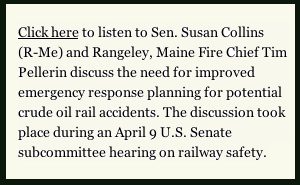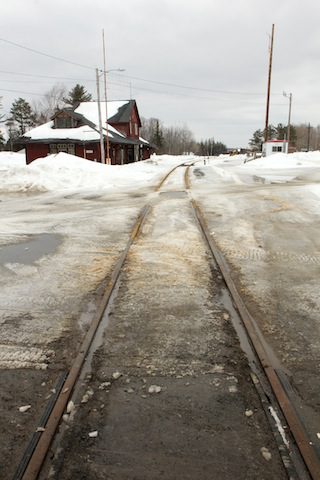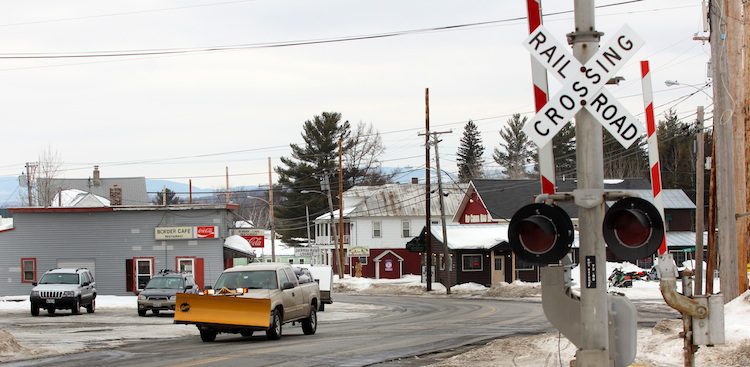Less than a year ago, a runaway train carrying crude oil derailed in Lac-Mégantic, a small Quebec town ten miles from the Maine border.
Thousands of gallons of the highly flammable crude oil spilled from ruptured tank cars, setting off fireballs in the town’s center that killed 47 people and destroyed 30 buildings. Some bodies were likely vaporized and never identified.
In Maine, trains carrying the same crude oil have been passing through dozens of communities, many as close to homes, businesses and people as in Lac-Mégantic.
Railroads carried 4.2 million barrels of crude oil — enough to fill 267 Olympic-size swimming pools — through Maine last year, up from 25,000 barrels in 2011, according to state Department of Environmental Protection (DEP) data. No crude oil shipments by rail have passed through Maine since last fall, according to state records, but industry experts say if shipping by rail becomes cheaper than other forms of transport, that could change.
They don’t know if the train is carrying potatoes, lumber — or crude.
“We always say, ‘It could have happened here!’” said Smyth.
And if it did happen in Jackman or Portland or any of the towns along the rail, is Maine prepared to fight a crude oil fire, save lives and protect the environment?
An investigation by the Maine Center for Public Interest Reporting reveals the burden for planning and responding to a Lac-Mégantic-level catastrophe will fall on state and local emergency services, which may not have all the information, training or material they could need.
The potential for a crude oil incident in Maine like the one in Lac-Mégantic has prompted three state emergency groups to make the issue a key topic at the April 22-23 statewide Emergency Management Conference in Augusta.
“We’ve been fortunate, but being fortunate doesn’t mean we’re prepared,” said Robert Gardner, a technological hazards coordinator at the Maine Emergency Management Agency, one of the conference organizers.
He pointed to another nearby incident, in New Brunswick, Canada, when on Jan. 7, eight cars carrying crude oil and propane derailed and generated a massive fire and cloud of orange smoke. “We need to learn what others have experienced so we can be better prepared,” Gardner said.
Federal regulators and industry observers say recent fiery derailments across the continent have revealed a glaring lack of emergency preparedness requirements.
Unlike the marine barges, pipelines and fixed facilities that have transported and stored crude oil for years, U.S. railroads are not federally required to have comprehensive plans for a worst-case oil disaster.
“It’s a big gap,” said David Willauer, of emergency management firm IEM and the former planning director for the Greater Portland Council of Governments.
“Now we have crude oil coming by in mile-long unit trains through remote areas along the U.S., and shipped to refineries on the coast … the oil-response plans need to have a land-based component to them.”
This gap has exacerbated the challenge of planning for oil disasters in rural states like Maine, where:
• State, county and local officials do not know the oil-spill response plans and capabilities of any railroad companies in Maine because the rail firms are not required to share or coordinate such information.
• The first people on scene at a rural oil incident will be declining numbers of volunteer firefighters who are hours from the highly-trained response teams and special kind of equipment, materials and gear needed to handle oil fires. Of 59 communities along rail lines, five have no fire department and 27 rely on solely volunteers.
• Like in all other states, no Maine officials are provided with any information about hazardous materials transported by rail through communities. Last month, Maine Emergency Management Agency (MEMA) asked Pan Am Railways for a list of the top 25 most hazardous goods shipped through Maine in 2013 and is awaiting a response, said agency director Bruce Fitzgerald.
The need to improve emergency response planning for crude oil rail disasters came up at an April 9 U.S. Senate Appropriations subcommittee hearing on railway safety, where both Sen. Susan Collins, a ranking member of the subcommittee, and Rangeley Fire Chief Tim Pellerin spoke on the need to better train and prepare rural firefighters.
“It’s also important to recognize that much of that rail network exists in rural America, and that presents unique challenges to small communities that often lack the resources to effectively respond to hazardous material emergencies,” Sen. Collins, a Republican, said at the hearing.
Feds don’t require emergency plans
Do railways transporting crude oil through Maine have adequate response plans in case a catastrophe happens? Thanks to a federal loophole, no one — including the state of Maine — knows.
Two railroads have carried crude oil from the Bakken shale region of North Dakota into Maine: Pan Am Railways and Montreal, Maine and Atlantic Railway, the carrier that operated tank cars that derailed and ruptured at Lac-Mégantic.
Pan Am Railways Executive Vice President Cynthia Scarano did not respond to repeated interview requests over the course of two months. MMA Railways filed for bankruptcy last August, when it also stopped shipping crude oil. The New York-based firm Fortress is in the process of purchasing its assets.
MMA Railways didn’t have sufficient resources to respond to Lac-Mégantic — and it would have been just as unprepared if it had happened in the U.S, according to the National Safety Transportation Board’s (NTSB) Jan. 23 letter to the Federal Rail Administration.
There are no federal rules for how railroads should prepare for any emergency involving hazardous materials, including crude oil, said Willauer.
“It’s all voluntary, and there’s no standard for what they need to do,” said Willauer, who has conducted studies of hazardous materials transport in states, including Maine. “So you have a pretty wide range of responses between railroads.”
The country’s seven Class 1 rail businesses, which have annual revenues of $250 million or more, have system-wide plans that include handling emergencies in local communities and sensitive geographic areas, according to Willauer.
“On the other end, you have railroads that may have only a rudimentary plan in place,” he said, noting there are 550 smaller railroads known as short-line and regional railroads. Maine is one of four continental states with no Class 1 carrier.
When it comes to oil spills — as opposed to emergency planning — railroads must write basic response plans, but they don’t need to be shared with state agencies or sent to the Federal Rail Administration.
These basic plans don’t include training drills and exercises, assigning a qualified individual to man the response or plans for a worst-case discharge — which can result in up to three million gallons spilled.
“[O]il spill response planning requirements for rail transportation of oil/petroleum products are practically nonexistent compared with other modes of transportation,” NTSB Chairman Deborah Hersman wrote to the federal Pipeline and Hazardous Materials Safety Administration on Jan. 21.
Railroads only have to file comprehensive plans if they haul a tank car with a 42,000-gallon capacity, and no tank cars currently in use can hold that much.
This means no shippers have to tell the government, or anybody, what they’d do in case of a disaster, even if they’re hauling ten average size-tank cars carrying a total 300,000 gallons of crude oil. The rule was developed at a time when crude oil wasn’t being shipped in trains that carry only crude and that can haul millions of gallons at once.
This current regulatory scheme “circumvents the need for railroads to comply with spill response planning mandates of the Clean Water Act,” Hersman wrote to the hazardous materials agency.
Comprehensive plans must only be submitted to the Federal Rail Administration, which is not required to review and approve them, Hersman wrote.
“It’s a pitiful pretense of regulation,” said emergency management consultant Fred Millar, who worked for the liberal activist group Friends of the Earth for 18 years. “Railroads have gotten themselves exempted from the same kind of response planning and right-to-know laws that apply to everyone else.”
If requirements had been updated as crude shipments began skyrocketing, the federal rail regulators could have required MMA Railway to plan for a disaster on the scale of Lac-Mégantic, wrote Hersman to the regulators.
“DEP and to some extent local communities have taken on that responsibility to be prepared in the event of a spill,” said Maine Department of Environmental Protection’s response director Peter Blanchard.
Responding to rail incidents is challenging in Maine, where railroads traverse cities, rural communities and bodies of water — many inaccessible by road, according to Blanchard.
In February, DEP asked Pan Am Railways for copies of their response plans, but never heard back, according to Blanchard.
Blanchard said railroads have made “some effort” to help DEP in preparing for an oil spill, citing a collaboration with MMA Railway that yielded a vulnerability map of sensitive natural resources and remote access points along rail lines.
The DEP has 25 spill responders, with five always on-call at offices in Portland, Augusta, Bangor and Presque Isle. Their equipment includes oil skimmers and two 5,000-barrel oil recovery barges stationed in South Portland and Bucksport.
Volunteers may be first to a crash
Recent train derailments involving crude oil and ethanol have raised a question for emergency planners: Who responds when incidents happen in the middle of nowhere?
“When they happen in remote areas, away from populated areas, you not only have fewer resources but volunteer fire departments that don’t necessarily have the capability to handle an incident of that size,” said Willauer of emergency management firm IEM.
About 90 percent of Maine’s firefighters are volunteer, estimates the Maine Fire Services Institute’s Bill Guimond.
“Probably the biggest challenge facing a lot of departments is just resources on the initial response, especially in the rural communities,” Guimond said. “Firefighters are not always available, and a lot of communities are strapped with resources right now.”
Along rail lines in Maine that have carried crude oil, five cities have professional departments. Nine small communities have no fire departments, 26 rely on an all-volunteer force and 19 rely on both volunteer and career firefighters.
“It’s certainly a different kind of response when you don’t have everybody right on-call all the time,” said MEMA’s Fitzgerald. “They have to get out of their job, they have to travel to get their equipment, they have to go and respond. Those communities rely almost entirely on mutual aid, because no one department up there is big enough to handle an event.”
If a rail catastrophe happens, local responders like firefighters would receive support from other towns through mutual aid agreements, 17 state-supervised hazardous material teams, spill responders, MEMA and, potentially, federal agencies and out-of-state and Canadian responders.
Since last July, two Maine hazardous material teams in Paris and Jonesboro have shut down because they lacked enough people to maintain staffing and training requirements. Rail communities like Jackman, Greenville and Vanceboro are up to two hours away from specially-trained teams in Orono, Skowhegan and Houlton.
Maine’s hazardous material teams train regularly for major oil fires, train rollovers and derailments, according to Hyland. In the past decade, Maine railways have provided locomotives and tank cars to train firefighters and spill responders, according to Blanchard.
Some fire officials said though they appreciate the seminars, training efforts with railroads are not institutionalized, proving a problem for departments with high rates of turnover.
Waterville Fire Chief David LaFountain asked Pan Am Railways last year for specialized training in dealing with volatile Bakken crude oil, but he never heard back from the railroad.
In Maine, the state and cities like South Portland have invested in the costly resources — like protective gear and specialized foam — needed for a fiery disaster even a fraction of Lac-Mégantic’s size.
In 2009, Maine Emergency Management Agency received a Homeland Security grant to buy three $80,000, 990-gallon foam trailers and placed them in South Portland, Searsport and Sweden. The Air National Guard at Bangor International Airport has 2,000 gallons of foam concentrate.
South Portland has 20,000 gallons of alcohol-resistant foam to smother petroleum fires. The city’s fire chief, Kevin Guimond, said his team is ready to respond statewide, with 64 full-time firefighters and paramedics and 40 on-call firefighters.
But that big cache of foam is four hours away from communities along rail lines like Jackman and Vanceboro. Half of communities on the rail lines are two to four hours away, with 15 facing wait times of more than three hours.
Information hard to get
Maine officials don’t know much about hazardous materials transported by rail, including what kinds go where, or when, how often, and how much they’re shipped. Railroads say sharing such information could jeopardize security.

“There’s a lack of rail transportation response plans because it’s hard to get the information,” said Willauer. “Many local officials don’t have an idea of what’s going along rails or highway corridor.”
Though U.S. railroads don’t have to disclose any information about hazardous materials to communities, they are not prevented from doing so.
Voluntary industry standards encourage railroads to do so, upon request, and as long as first responders do not make such information public.
MEMA’s Fitzgerald wrote to Pan Am on Feb. 7 requesting a list of the top 25 most hazardous materials transported through Maine in 2013. He is still awaiting a response.
Currently, first responders can figure out what a derailed train car is hauling by reading the placard affixed to the side of a rail car, finding the crew member who has a paper document showing where hazardous materials are located on the train, or calling the railroads’ 1-800 number.
According to an 1817 Congressional act and the interstate commerce clause, railroads can’t refuse to ship anything, including hazardous goods, and only the federal government can restrict such movement, said Mark Hyland, MEMA’s operations and response director.
“But you know, having said that, we’d like to know what’s coming through, just so we can prepare our communities and our regional response teams for what they’d see,” he said.
LaFountain said in his opinion, the rail yard in Waterville — a town where trains carrying crude pass through — is his city’s “most dangerous spot,” and he worries how his team could respond if there was a crude oil emergency.
“To be honest with you, when I saw what happened in Lac-Mégantic, the behavior of the product catching fire and having the ignition it had and the fire conditions it had, that wasn’t what I expected for typical crude oil,” said LaFountain. “Now hearing that this crude oil is different because of where it comes from, it raises concern. It’s not safe.”
Facts about crude-by-rail in Maine
Railroads carried 4.2 million barrels of crude oil — enough to fill up 267 Olympic-size swimming pools — through Maine last year, up from 25,000 barrels in 2011 and down from 5.2 million barrels in 2012.
The 2013 amount does not include the months of April to August when Pan Am Railways temporarily stopped reporting how much crude oil it shipped into Maine and paying into the state’s three-cent per barrel oil spill clean-up fund, according to Department of Environmental Protection spokeswoman Jessamine Logan.
At the time, the company told the Bangor Daily News that state law did not specifically require them to do so. The state legislature revised the statute effective last October.
After several fiery train explosions involving crude from the Bakken shale region of North Dakota, federal regulators issued a Jan. 2 warning that the crude may be more flammable than other varieties. A federal “Bakken Blitz” investigation has revealed that in 11 out of 18 random samples, Bakken crude was misclassified as a less volatile variety.
Three railroads — Pan Am Railways, Montreal, Maine and Atlantic Railway, and Eastern Maine Railway — have carried Bakken crude oil through Maine to an Irving Oil refinery in St. John, New Brunswick.
The MMA Railway line enters Maine at Jackman and then traverses across central Maine to Mattawamkeag. The now-bankrupt company, whose assets are in the final steps of being purchased by a New York-based investment firm, stopped carrying crude oil last August.
A Pan Am line enters Maine at South Berwick and carries crude through towns near Interstate 95, including Portland and Bangor, before heading to Mattawamkeag.
There, the J.D. Irving subsidiary Eastern Maine Railway transports the crude oil from Mattawamkeag, to Vanceboro, to the refinery. Eastern Maine Railway does not pay into the clean-up fund because state law only impacts carriers bringing oil into Maine, according to Logan.
In Maine, crude oil shipments by rail have dropped off since last fall, but industry experts say dynamic global oil prices could quickly change that.
North Dakota Department of Mineral Resources director Lynn Helms has estimated that up to 90 percent of the state’s crude will be transported by rail in 2014.
Following growing scrutiny on the rupture-prone DOT-111 tank cars involved in recent derailments, Irving Oil announced in February that by April 30, it will voluntarily retrofit its crude oil fleet to meet higher standards recommended by the Association of American Railroads for tank cars built after 2011.
Even stricter federal standards for the tank cars could be released by the end of 2014, said Cynthia Quarterman, head of the Pipeline and Hazardous Materials Safety Administration at a Feb. 26 Congressional hearing.
Last year, U.S. railroads spilled more crude oil — 1.15 million gallons — than in the last 38 years combined, according to a McClatchy news service analysis of federal data that does not include the 1.6 million gallons spilled in Lac Megantic.
The Association of American Railroad states that through 2010, 99.9977% of rail shipments of hazardous material reached their destination without a release caused by a train accident.
In Maine, railroads have spilled more than 200 gallons of hazardous materials like flammable gas oil and sulfuric acid since 2003, according to a review of Pipeline and Hazardous Materials Safety Administration data. This represents a large decrease from the 120,000 gallons of hazardous materials like fuel oil and sulfuric acid reported spilled between 1976 to 1999.
Approximately one gallon of crude oil spilled in March of 2013, when 13 tank cars operated by Pan Am Railways derailed near the Penobscot River in Mattawamkeag, according to a report filed to the National Response Center. Each car in the 96-car unit train was carrying 31,000 gallons of crude.
CORRECTIONS: An earlier version of this story referred incorrectly to the name of an employee of the Department of Environmental Protection. His correct name is Peter Blanchard. The state’s cleanup fund was incorrectly characterized; it is a three-cent-per-barrel oil spill cleanup fund. And the ownership of the Eastern Maine Railway was incorrectly characterized; is owned by J.D. Irving.
This is part one of a two-part series.







